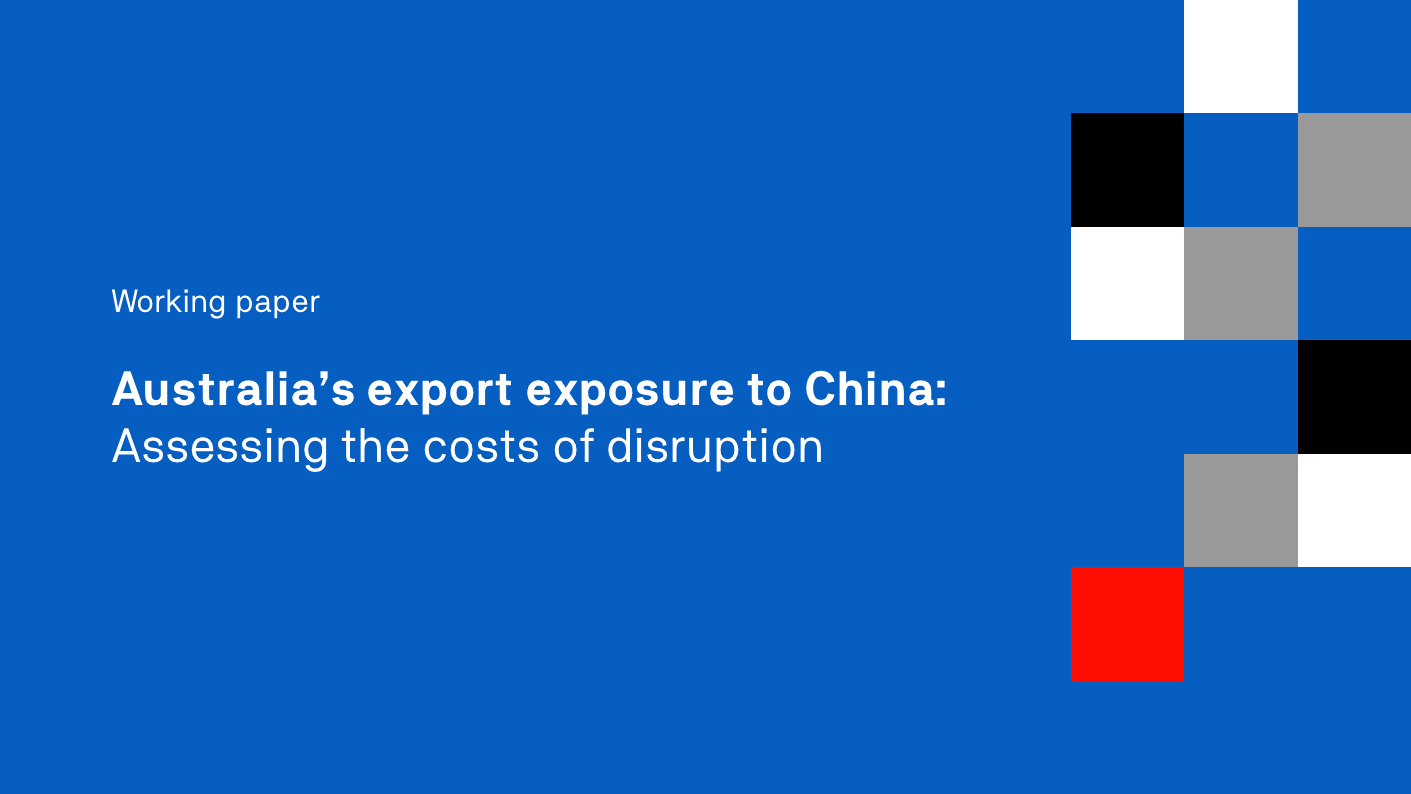Australia’s export exposure to China: Assessing the costs of disruption
September 09 2021

A video summary of the working paper is available.
Executive Summary
- Australia’s exports to the People’s Republic of China (PRC) are being recast in terms of risk rather than opportunity. Exposure to the PRC market is seen as providing Beijing with coercive leverage that can erode sovereign decision-making in Canberra. Further, because this trade is mostly undertaken by private businesses that are focused on their own profits and not Australia’s broader strategic and national security concerns, public policy intervention aimed at cutting this exposure is touted as both necessary and desirable. Amplifying this view is a campaign of disruption that Beijing has directed at Australia’s exports since May 2020. Australia’s recent experience has been held up as a warning for other countries, particularly liberal democracies, as to why exposure to the PRC market is potentially dangerous. There has also been much discussion about directing public policy resources and energy into re-purposing narrow coalitions like the ANZUS alliance, the ‘Quad’ and/or the Five Eyes intelligence-sharing arrangement for geo-economic objectives, including to deter and respond to economic coercion by the PRC.
- A logical starting point to analysing these issues is to put Australia’s export exposure to the PRC into perspective. Medium-sized economies like Australia that require openness to prosper will inevitably develop significant aggregate exposures to much bigger ones. In 2020, just two economies – the PRC and the US – accounted for a combined 34.2 percent share of the global economy. The Australian Productivity Commission recently argued that Australia’s exposure to its top 10 markets is not unusual compared with the global average. This paper finds that even if only the top market is considered and Australia is benchmarked against ‘peer’ economies, the degree of exposure to the PRC has, for the most part, not been unusual. It was only in 2020 when 41 percent of goods exports went to the PRC that Australia appeared as an outlier. However, this heightened exposure is a temporary phenomenon, reflecting historically high prices for iron ore. Further, it has not come with greater risk because what it demonstrates is the PRC’s ongoing reliance on Australia to supply big-ticket items like this essential, steel-making ingredient. Even today, the annual value of goods exports to the PRC is 3.8 times that to Japan, Australia’s second largest international customer. If iron ore is excluded, goods exports to the PRC remain 20 percent higher than those to Japan.
- At an industry level, ‘cost guides’ are calculated to gauge the scale of the trade fallout from Beijing’s campaign of disruption. For nine of the 12 goods considered, these guides suggest that the cost incurred by Australian exporters has been less than 10 percent of the latest total export value. It is also shown that some of the industries with the highest proportion of exports going to the PRC, such as barley and cotton, have subsequently incurred the lowest costs when that market closed. The key issue is not exposure but access to an effective mitigation mechanism. Mitigation in the form of Canberra providing businesses with financial assistance, or supporting actions by Washington and other geopolitically-aligned capitals, has been almost entirely absent to date. The costs incurred by many Australian businesses have, however, been lowered significantly by markets. There are some exceptions, such as wine and wood (rough). And for others like rock lobster, the mitigation provided by markets is more perilous because it relies on PRC authorities turning a blind eye to a thriving ‘grey trade’.
- The implications of these results are several. First, they serve as a corrective to the claim that Australian businesses with a high exposure to the PRC are necessarily naïve or irresponsible. In fact, the findings show that many business owners were able to secure premium prices in the PRC for an extended period, and when this opportunity closed, they quickly and successfully pivoted to alternative markets. This highlights an awareness of both opportunities and risks, which has bolstered not only private profits but the broader national interest too. Second, market access is revealed to be a weak coercive tool for Beijing. This means what the PRC may hope to achieve by disrupting trade is not the same as what it is likely to achieve. Put another way, exposure to the PRC market and Australian sovereignty can co-exist. Third, given that public policy resources are finite and interventions are not cost-free, and many Australian businesses already have access to effective risk mitigation mechanisms, the case for government to take a more prescriptive approach to business engagement with the PRC is more limited than commonly imagined. There is a case for government to invest in ‘collective action’ pushback against Beijing’s economic coercion but if the point is to get the PRC to ‘play by the rules’ and to expand the range of activities covered by these rules, narrow coalitions offer little positive return compared with multilateral institutions like the World Trade Organization (WTO) that have broad legitimacy.
- A caveat that applies to the analysis is that it is concerned with a contemporary assessment of risk. In the medium and long-term, there is the prospect of costs increasing. This could be because export disruption extends to services like tourism and education when borders reopen following the COVID-19 pandemic, the PRC market outperforms the alternatives that Australian producers still have access to, or Beijing successfully finds alternative suppliers for big-ticket items like iron ore. There is a recognition, too, that the costs to exports from the political breakdown between Canberra and Beijing is not the only, or the biggest, problem. Australia’s strategic, security and other national interest objectives are difficult to achieve in the absence of a productive, working relationship with the region’s dominant power.
Authors: James Laurenceson, Director, Australia-China Relations Institute, University of Technology Sydney; Thomas Pantle, Project and Research Officer, Australia-China Relations Institute, University of Technology Sydney.
Notes: UTS:ACRI working papers are research papers in progress. Feedback is welcomed by the author(s).


